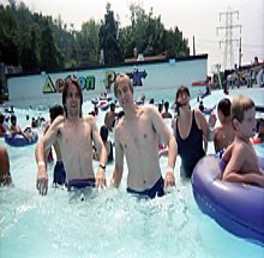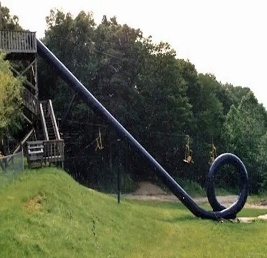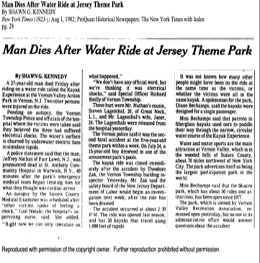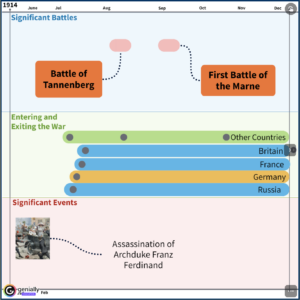
Imagine it’s a hot summer weekend in the 1980s. You sit in front of the television and excitedly turn it on. A commercial advertises countless fun and exciting rides with the slogan, “There’s Nothing in the World like Action Park!”1 You beg your parents to go. However, they refuse to go due to financial reasons. Then, a few months later, an unfortunate guest of Action Park dies on its famous Alpine Slide. If you had a choice to go, knowing that someone had died there, would you still go to Action Park? How did Action Park turn from one Alpine Slide at a resort to the most dangerous theme park in the world, and why did people still go, knowing that it could be their last?

Eugene Mulvahill was an optimistic entrepreneur. In the 1970s, he ran a company named Mayflower Securities, selling what are known as petty stocks. He would trick people into buying stocks in essentially worthless companies. Mulvahill, and his best friend, Robert Brennan, were having the time of their lives with their pump-and-dump schemes. However, their luxurious reign in the company would soon end; the Securities and Exchange Commission suspended their company for selling “worthless securities.”2 After being left without a job, Mulvahill sought something more exciting than selling penny stocks. He wanted something that could create more cash flow than working on Wall Street; thus, he bought two ski resorts in the town of Vernon, New Jersey. When many think of “ski resorts,” states like Colorado, Utah, and even Nevada are pictured in terms of having suitable climates for skiing. Not many people would think of New Jersey, let only the town of Vernon, which begs the question, why did Mulvahill even dare to pick this specific town? It was because of the owner of Playboy, the magazine company’s very own creator, Hugh Hefner. As crazy as that sounds, Hefner believed that Vernon had the potential to become “the new Las Vegas,” as gambling was seemingly becoming more popular in Atlantic City, New Jersey. Furthermore, he thought that Jersey was on its way to becoming the same. Thus, a small town, Vernon, New Jersey, got its very own Playboy club. After Hefner’s bold decision in Vernon, Mulvahill, using his past experiences on Wall Street, took the risk and became the owner of Great Gorge and Vernon Valley resorts. Surprisingly, the two ski resorts did well for the town of Vernon, due to Mulvahill’s significant investment in artificial snow. As it turns out, Eugene helped create the “world’s largest snowmaking system,” allowing many tourists, locals, and guests to ski in the land of New Jersey during winter.3 But Eugene wasn’t satisfied that his resorts were only doing well in the winter, and would have downtimes during the summer. So, after careful consideration, he planned to create an amusement park with the creation of his first ride, the Alpine Slide. The Alpine Slide was a slide where you could manually control the slide’s direction and speed as it raced down the track. It was a massive success. The fame inspired Mulvahill, with the help of his previous partner and best friend, Robert Brennan, and the Great American Recreation Company’s funding, to rename Vernon Valley to Action Park, a theme park with 75 different rides and three distinct sections, the Alpine Center, Motorworld, and the famous Waterworld.4
The Alpine Center, which was in the middle of the park, included rides and activities that didn’t need water or motor-based vehicles. It instead opted for rides that the guests could operate and experience for themselves. These rides included the famous Alpine Slide, but also the Snapple Snap-Up Whipper Snapper ride, which was a bumping-jumping attraction in which two-to-four people were strapped to a rope and they would all jump off a massive tower. Another ride was the Action Park Gladiator Challenge, which was a gladiator-themed obstacle course where guests would have to fight off the Action Park Gladiators. Another of the rides included the Transmobile, which took two guests from the Alpine Center to Motorworld. Unlike the rest of the other “worlds,” the Alpine Center also had a short-lived skateboard park, areas to buy food, festival tents, and even a brewery. However, Motorworld, and Waterworld, were the destinations where the real fun began at Action Park.5
Motorworld, which was at the bottom of the park, is, as its title describes, a series of rides with motors, specifically, vehicle-based rides, such as cars, boats, and even tanks. Some of the rides in this section included the Super Go-Karts, Lola Cars, Battle Action Tanks, SuperSpeed Boats, and Bumper Boats. The Super Go-Karts and Lola Cars were race-themed attractions where guests could drive vehicles around a track that differed based on which ride they went on. For example, Super Go-Karts had guests ride on a small looping track, while Lola Cars had guests ride on a longer route with twists and turns in karts that reassembled race cars. The SuperSpeed Boats was where guests could drive separate boats in a circle in a small pond. Bumper Boats were motorized rafts that guests drove and could collide with others with turrets that could spray water at the other attendees. Battle Action Tanks were similar to this, except it was on land and they would shoot tennis balls at their opponents. These tanks were small and enclosed, so guests that rode them never got hit by the artillery. In addition to these rides, two slingshot-based attractions were available for those who sought the thrill of being shot up into the air and falling back onto the ground. Motorworld had its share of enjoyable rides; however, Waterworld brought guests into Action Park because of its extreme and severe rides.6

Waterworld, which lived at the top of Action Park, was the most popular of the three sections, as it had the most rides as well as having the most extreme rides at the park. The most extensive section had various rides that guests could choose from, like jumping cliffs, mat-based slides, lazy rivers, water rapids, wave pools, swings, and kayaking. These included rides such as the Kayak Experience, which had fans in the water that could simulate water rapids, where guests could feel what it was like to kayak in extreme measures; and the Tarzan Swing had guests swing from a platform into a small pool of cold water. Another attraction was the Tidal Wave Pool, where waves were generated every 20 minutes that reached up to 3 feet. However, this section’s most extreme and famous attractions were the water slides. Action Park’s water slides were harsh, such as “Geronimo Falls,” where two giant vertical water slides had guests go down the slides at high speeds. However, the one slide that was the most insane, most severe, and most concerning was the Cannonball Loop, which was a water slide that had a loop similar to what many rollercoasters have today. According to previous park employees, Mulvahill offered $100 to any employees who would try the slide. Test dummies sent on the ride arrived beheaded at the end of the ride. When the slide opened, guests who wanted to ride the slide were hosed down with water and were instructed how to go down the slide to prevent as much injury as possible. While a hatch was built at the top to rescue riders who got stuck at the top of the loop, many riders experienced bloody noses and various other injuries. However, the Cannonball Loop is just the beginning of the many injuries and deaths that Action Park had collected in its operation time.7
Action Park, in its entirety, has had an excessive number of injuries and problems, with a multitude of them coming from Motorworld alone. In Motorworld, SuperSpeed Boats’ pond had a massive amount of snakes living in its waters; and guests would treat the boats as if they were on Bumper Boats. On the other hand, Bumper Boats were often prone to leak gasoline, which caused a rider to be medically examined after too much oil was leaked onto his skin. Tall guests would have multiple leg injuries, as they had to hang their legs on the sides of the boats, leading to many bone fractures when colliding with other boats. On Battle Action Tanks, many guests would fire at employees that tried to fix tanks that stopped working, leaving them with bruises. On Super Go-Karts and Lola Cars, employees discovered that tampering with the karts with tennis balls would allow the karts to go past their top speed. This allowed employees to use the Lola Cars on the nearby freeway. In Waterworld, lifeguards had to constantly save kids who started to drown due to the waves at the Tidal Wave Pool. Apart from injuries caused by rides, injuries came from Action Park’s own reckless decisions. Due to the park’s decision to allow drinking, teenage employees would allow those under the legal age of drinking to have alcohol. In addition, Action Park was marketing toward Polish and Spanish families, most of which couldn’t speak English. Therefore, employees had to assist and watch drunk underage teenagers, people who couldn’t understand, and regular park-goers. It can be reasonable to believe why death was prominent in Action Park’s history with all this in mind.8

Death is tragic, especially in amusement parks, where safety and security should be the top priority. But in Action Park, death was only a mere routine, which Mulvahill didn’t actively try to stop, but rather tried to cover and avoid. On July 8, 1980, an employee riding the Alpine Slide flew off the pipe, hitting a rock, and was instantly killed.9 On August 1, 1982, a 27-year-old man fell off his kayak on the Kayak Experience, touching the electrical wiring powering the fans in the water, killing him.10 In 1984, a guest swinging on the Tarzan Swing died after getting a heart attack after impacting the cold water, unable to adapt to the changing temperatures fast enough.11 That same year, on August 27, a man drowned in an overcrowded pool after not being seen by the 20 lifeguards on duty.12 Three years later, in 1987, an 18-year-old drowned in the Tidal Wave Pool after being overtaken by the massive waves.13 With the number of deaths in the parks, one can assume that these would be why Action Park would shut down due to lawsuits; however, that would be incorrect. Mulvahill successfully dodged many cases of injuries and deaths. This was due to the park’s reputation, where injuries were a selling point and New Jersey’s flexible laws on attractions and water parks. However, some of the casualties were caused by neglect on the part of the employees; Action Park was successfully sued. Mulvahill pleaded guilty to 5 charges of insurance fraud due to him lying about the number of guests that entered the park, stating that the number of guests outweighed the number of injuries and deaths. However, Vernon’s local Emergency Room claimed that they would have to treat five to ten guests’ injuries a day, depending on the number of people inside the park. Even with Mulvahill in massive amounts of legal trouble, this was not the final factor in the death of Action Park. Their partner company funding their expenses, the Great American Recreation Company, would be its downfall.14
Action Park continued regularly operating until December 2, 1996, when it closed its doors. The Great American Recreation declared bankruptcy; it was no longer able to expend money for the park to continue operating. Vernon Valley and the park would be handed over to another company, which would rebrand the area as Mountain Creek Water Park. Unfortunately, Mountain Creek also declared bankruptcy, just like its predecessor, and the park was sold back to the Mulvahill family. In 2014, after Mulvahill’s death, his son, Andy, wanted to continue the legacy that his father left him and brought Action Park back from the dead. Action Park’s resurrection brought all the attractions people loved with new safety protocols. For example, engineers were building a brand new version of the Cannonball Loop, but this one prioritized safety. But even the original creator’s son couldn’t save Action Park from its inevitable fate, as attendance rates decreased dramatically due to the surrounding aura of death that plagued the park. Finally, in 2016, Action Park was renamed back to Mountain Creek to separate itself from its reputation, and it is still open to this day.15
Action Park will be remembered by the people who attended as a once-in-a-lifetime experience. Vernon locals fondly cherish the park and look back on the injuries as childhood memories despite its tragic history. As for others, Action Park serves as a cautionary tale that not everyone should be qualified to open an amusement park and that safety should always be a priority.
- hereinmylifetime, Action Park Commercial, 2009, https://www.youtube.com/watch?v=VKWJpFEJw9M. ↵
- “Action Park Documentary,” CLASS ACTION PARK, accessed January 26, 2022, https://www.classactionpark.com. ↵
- “Action Park Documentary,” CLASS ACTION PARK, accessed January 26, 2022, https://www.classactionpark.com. ↵
- “Action Park Documentary,” CLASS ACTION PARK, accessed January 26, 2022, https://www.classactionpark.com. ↵
- Kevin Purjuer, Defunctland: The History of Action Park, 2017, https://www.youtube.com/watch?v=flkW-ceNvck. ↵
- Kevin Purjuer, Defunctland: The History of Action Park, 2017, https://www.youtube.com/watch?v=flkW-ceNvck. ↵
- Kevin Purjuer, Defunctland: The History of Action Park, 2017, https://www.youtube.com/watch?v=flkW-ceNvck. ↵
- Kevin Purjuer, Defunctland: The History of Action Park, 2017, https://www.youtube.com/watch?v=flkW-ceNvck. ↵
- Kevin Purjuer, Defunctland: The History of Action Park, 2017, https://www.youtube.com/watch?v=flkW-ceNvck. ↵
- SHAWN G. KENNEDY, “Man Dies After Water Ride at Jersey Theme Park,” New York Times, 1982. ↵
- Kevin Purjuer, Defunctland: The History of Action Park, 2017, https://www.youtube.com/watch?v=flkW-ceNvck. ↵
- “Brooklyn Man Drowns in Pool At a Jersey Amusement Park,” New York Times, 1984, sec. METROPOLITAN REPORT. ↵
- “18-Year-Old Drowns At Amusement Park,” New York Times, 1987, sec. Metropolitan News. ↵
- Kevin Purjuer, Defunctland: The History of Action Park, 2017, https://www.youtube.com/watch?v=flkW-ceNvck. ↵
- Kevin Purjuer, Defunctland: The History of Action Park, 2017, https://www.youtube.com/watch?v=flkW-ceNvck. ↵



42 comments
Priscilla Leal
Growing up I never really visited amusement parks, during this time I would occasionally hear stories about similar accidents occurring and felt some kind of relief that I wasnt there to witness it. This article shows how much people are willing to risk it just for the thrill of it which can be ignorant at times. Im grateful to know that this article spreads awareness about the legal aspects of running an amusement park.
Iris Reyna
Congrats Dylan on winning the Spring 2022 award for Best Publication in the Humanities category. The article was very informative due to the fact that I’d never heard of Action Park before reading this article. It was also heartbreaking to read about all the people who were hurt or died at the park during its operation, which is astonishing to believe it was even able to operate due to all the dangers and flaws of the park. But it wasn’t one-sided because even though it operated people still continued to go to the park even though they knew what could happen. Good job on the research and the photos of the park did a good job of showing how dangerous the park really was.
Carolina Wieman
Action Park is a WILD amusement park with unregulated rides and untrained teenage staff. Personally, it sounds like a PR nightmare but I would totally go. This place with almost like a teenage free for all and a place where kids could live without rules. Unfortunately, people did lose their lives either by drowning or going on intense roller coasters. This park changed the way people and the government regulated theme parks and from now on try to forever avoid another Action Park disaster.
Clarissa Liscano
I’ve never been a fan of any amusement park since, in my opinion, they just scream danger. Either the risk of getting lost and taken, or the risks associated with the rides. Every time you ride a ride, you are taking a risk since you never know when the machine can break down or if there is a lack of safety on one, as this article has only served to confirm. Even after learning about the regular incidents that take place there, I’m shocked that people still visited that location. It only demonstrates the existence of individuals who are prepared to enjoy themselves at any cost. Amazing article, and super interesting.
Luke Rodriguez
This was a very interesting and scary article. There have been many stories and news articles about accidents at amusement parks. The story of this park seems to be the most concerning in regard to safety which has changed the way employees run parks today. Even with the designs of the water slides, it did not look like it was safe. The last thing you would expect from a day of fun is death
Abbey Stiffler
I really like your introduction because it painted the scene where you could put yourself in someone else’s shoes. I think all action parks are dangerous to a certain extent but this one might just have more deaths overall. I think the reason people still kept going is a lot of young adults live for the thrill and that feeling was satisfied by the amusement park.
D'vaughn Duran
Thanks for the great information article! I didn’t even know this was allowed to even run! This seemed like a great wake up call to most amusement parks what not to do really. With them allowing death and injuries to many people during this time and also letting employees getting hurt with these rides just yells out caution in this park. It seems like a huge place back in the 1980-1990s to avoid even with a new owner running it. This article is a great information piece and kept the reader engaged with the history of the park!
Marissa Rendon
This article was a very interesting article. I love amusement parks although i have never been to a water amusement park I think all parks are fun and interesting. As much as i love rollercoasters this article definitely was an eye opener and has me sorta thinking now that all rides can be very dangerous and can easily be covered up by the media. I feel as if most amusement parks sorta aren’t the best at times when it comes to preventing an accident. I was very shocked to find out how people still continued to go to ActionPark after the past incident’s that took place.
Rafael Portillo
Thank you for this article. As a lifeguard I take water safety very seriously. I cannot believe a place like this existed. If a waterpark had so many injuries and cases I would close the park. I don’t know how this park was able to stay open after everything. It is so scary to be on a ride that will end with my life.
Ana Barrientos
Great article! Honestly, the article made me question a lot of amusement parks, I love rollercoasters and super fun rides but there has been so many incidents and it makes me scared to even get on a ride. It’s also very crazy that people were still going to that park when there were so many accidents and so many tragedies there. Personally, I would be terrified to go to a park that had so many tragedies. Overall, great job.